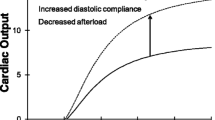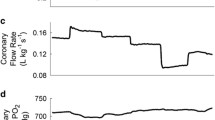Summary
The extent to which conclusions about myocardial performance may be drawn from end-systolic pressure-volume relations was investigated. Left ventricular isovolumetric and end-systolic pressure-volume relationships were measured in the rat, under acute impairment of contractility (hexobarbital), at chronic pressure overload (spontaneously hypertensive rats), and at chronic volume overload (aortocaval shunt). Our results confirm the classic conception of Otto Frank where the curves of the isovolumetric maxima and the curves of the end-systolic pressure-volume relations follow separate courses. Acute alterations in contractility can be detected from shifts in the end-systolic pressure-volume relations. In chronic pressure or volume overloaded hearts the end-systolic pressure-volume relations do not render conclusions about ventricular or myocardial performance since in chronically altered hearts, the course of the end-systolic pressure-volume relations is primarily influenced by geometric factors.
Similar content being viewed by others
References
Brilla Ch, Jacob R, Kissling G (1983) Determination of left ventricular wall stress and elasticity in situ. A methodological investigation. In: Jacob R, Gülch RW, Kissling G (eds) Cardiac adaptation to hemodynamic overload, training and stress. Steinkopff Verlag, Darmstadt, 354–363
Flaim SF, Minteer WJ, Nellis SH, Clark DP (1979) Chronic arteriovenous shunt: evaluation of a model for heart failure in rat. Am J Physiol 236:H698-H704
Frank O (1895) Zur Dynamik des Herzmuskels. Z Biol 32:370–447
Gehl H, Graf K, Kramer K (1955) Das Druck-Volumdiagramm des Kaltblüterherzens. Die Bedeutung des plastischen Elements für die Herzmechanik. Pflügers Arch 261:270–294
Hild R, Sick L (1955) Das Druck-Volum-Diagramm des isolierten spontan schlagenden Katzenherzens. Z Biol 107:51–66
Holt JP (1957) Regulation of the degree of emptying of the left ventricle by the force of ventricular contraction. Circ Res 5:281–287
Jacob R, Weigand KH (1966) Die endsystolischen Druck-Volumenbezichungen als Grundlage einer Beurteilung der Kontraktilität des linken Ventrikels in situ. Pflügers Arch 289:37–49
Kissling G, Gack K (1970) Quantitative Untersuchungen über das Ausmaß der elastischen Hysterese beim linken Ventrikel des Hundeherzens. Pflügers Arch 316:R13
Kissling G, Jacob R (1972) Begrenzende Faktoren für die Steigerungsfähigkeit des Schlagvolumens durch positive Inotropie. Untersuchungen am suffizienten Herzen unter fortgesetzter postextrasystolischer Potenzierung. Pflügers Arch 335:153–166
Kissling G (1976) Dynamik und Leistungsfähigkeit des linken Ventrikels im akuten und chronischen Versuch. Habilitationsschrift; Tübingen, 99–102
Kissling G, Gassenmaier T, Wendt-Gallitelli MF, Jacob R (1977) Pressure-volume relations, elastic modulus and contractile behaviour of the hypertrophied left ventricle of rats with Goldblatt II hypertension. Pflügers Arch 369:213–221
Mehmel HC, Stockins B, Ruffmann K, v Olshausen K, Schuler G, Kübler W (1981) The linearity of the end-systolic pressure-volume relationship in man and its sensitivity for assessment of left ventricular function. Circulation 63:1216–1222
Mercadier JJ, Lompré AM, Wisnewsky C, Samuel JL, Berovici J, Swynghedauw B, Schwartz K (1981) Myosin isoenzymic changes in several models of rat cardiac hypertrophy. Circ Res 49:525–532
Reichel H (1939) Die Beziehungen zwischen Länge und Spannung, Volumen und Druck des Herzmuskels. Z Biol 99:63–79
Sagawa K (1978) The ventricular pressure-volume diagram revisited. Circ Res 43:677–687
Sagawa K (1981) The end-systolic pressure-volume relation of the ventricle: definition, modifications and clinical use. Circulation 53:1223–1227
Sandler H, Dodge HT (1963) Left ventricular tension and stress in man. Circ Res 13:91–104
Suga H, Sagawa K, Shonkas AA (1973) Load independence of the instantaneous pressure-volume ratio of the canine left ventricle and effects of epinephrine and heart rate on the ratio. Circ Res 32:314–322
Suga H, Sagawa K (1974) Instantaneous pressure-volume relationships and their ratio in excised, supported canine left ventricle. Circ Res 35:117–126
Sulzer R (1932) Die mechanischen Eigenschaften des Herzmuskels. Z Biol 92:545–554
Ullrich KJ, Riecker G, Kramer K (1954) Das Druckvolumdiagramm des Warmblüterherzens. Isometrische Gleichgewichtskurven. Pflügers Arch 259:481–498
Vogt M, Jacob R (1985) Myocardial elasticity and left ventricular distensibility as related to oxygen deficiency and right ventricular filling. Analysis in rat heart model. Basic Res Cardiol 80:537–547
Weber KT, Janicki JS, Hefner LL (1976) Left ventricular force-length relations of isovolumic and ejecting contractions. Amer J Physiol 231:337–343
Author information
Authors and Affiliations
Additional information
Dedicated to Professor R. Jacob on the occasion of his 60th birthday.
Rights and permissions
About this article
Cite this article
Kissling, G., Takeda, N. & Vogt, M. Left ventricular end-systolic pressure-volume relationships as a measure of ventricular performance. Basic Res Cardiol 80, 594–607 (1985). https://doi.org/10.1007/BF01907858
Received:
Issue Date:
DOI: https://doi.org/10.1007/BF01907858




